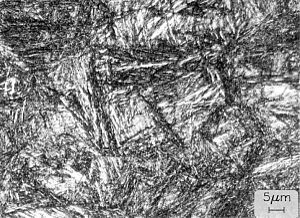انواع ریزساختار های فولادی
Ferrite[ویرایش]

The solid solution of carbon intercalation in alpha iron (α-Fe, cubic iron) is called ferrite. The solubility of carbon in ferritic iron is much lower than its solubility in austenitic iron, so that the maximum concentration of carbon in ferrite is about 0.02% by weight at a temperature of 727 degrees Celsius. The tensile strength of ferrite is about 40,000 psi.
Austenite[ویرایش]

The name of this phase is taken from William Chandler Roberts-Austen, an English metallurgist. Austenite is a solid solution of carbon intercalation in gamma iron (center-filled cubic iron). By entering the austenite crystal lattice, carbon expands the formation and stability of austenite in steels. With the addition of carbon, the austenite stability zone increases from 912 to 1394 degrees Celsius, which is the range of austenite iron formation and stability, to a wide range of temperature and chemical composition. The maximum solubility of carbon in gamma iron is 2% at a temperature of 1147 degrees Celsius. Austenite is not stable at ambient temperature.
cementite[ویرایش]

Cementite or iron carbide is a chemical compound with the formula Fe3C and has 6.67% carbon with an orthorhombic crystal structure. Phase cementite is very hard and brittle. In cementite, the bond between iron atoms is completely metallic, while the bond between iron-carbon atoms is still not completely clear. Two components of carbon and iron exist in the cementite network as positive ions. In other words, carbon and iron both act like metals. In fact, it is the above conditions and the presence of physical bonds in cementite that give it metallic properties (electrical conductivity, thermal conductivity and metallic luster, etc.).
Ledbury[ویرایش]

Lefebvrite is a eutectic mixture of austenite and cementite, which is obtained from a melt with 4.3% carbon at a temperature of 1147 degrees Celsius under a eutectic reaction. Since austenite is not stable at ambient temperature and turns into pearlite based on a eutectoid reaction, so the structure of laborite will be pearlite and cementite at ambient temperature. The name of this structure is taken from the German metallurgist Carl Heinrich Adolf Led Boer.
pearlite[ویرایش]
Pearlite is a eutectoid mixture of ferrite and cementite. Pearlite undergoes a eutectoid transformation from gamma iron with 0.8% carbon at 723°C. The tensile strength of pearlite is three times that of ferrite, that is, about 120,000 psi.

Bainite[ویرایش]

Bainite is a microstructural product resulting from eutectoid decomposition. This structure is created when a high-temperature phase breaks down into two different phases during cooling. The difference between this structure and pearlite is in its morphology. Binit occurs when the growth rate of two phases is different. Although the bainite structure has been seen in many non-metallic alloys, research in this field has mainly focused on steel alloys.
Martensite[ویرایش]
Martensite is generally referred to as crystalline structures formed by martensitic transformation. But this term is mostly referred to martensite phase in hardened steels. If the austenite is cooled so fast that none of the permeation-based transformations occur in it and the supercooling continues to the extent that the bcc structure is not stable, this structure will shear to face, which is supersaturated with carbon. The resulting phase is called martensite. Martensite is named after the German metallurgist Adolf Martens.

This article was published by Amir Ali Alani for the science and materials course.
This article "انواع ریزساختار های فولادی" is from Wikipedia. The list of its authors can be seen in its historical and/or the page Edithistory:انواع ریزساختار های فولادی. Articles copied from Draft Namespace on Wikipedia could be seen on the Draft Namespace of Wikipedia and not main one.
